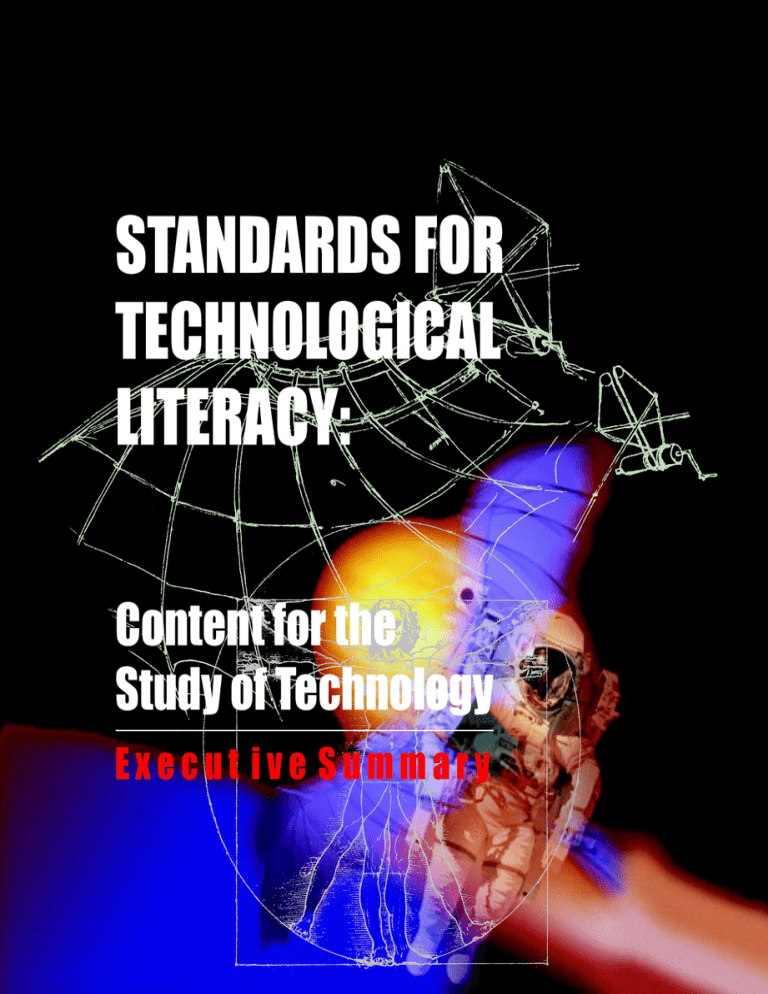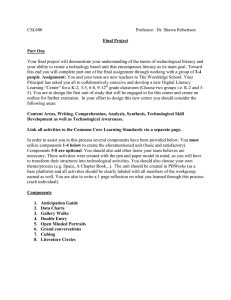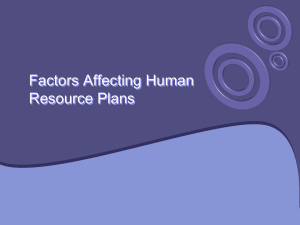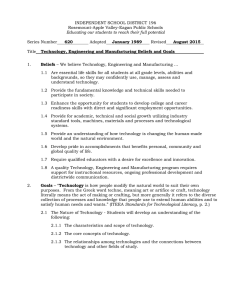
STANDARDS FOR
TECHNOLOGICAL
LITERACY:
Content for the
Study of Technology
Execut ive Summary
The International Technology Education Association and its Technology for All Americans Project
developed Standards for Technological Literacy: Content for the Study of Technology
through funding from the National Science Foundation under Grant No. ESI-9626809 and the
National Aeronautics and Space Administration under Grant No. NCC5-172. Any opinions, findings,
and conclusions or recommendations expressed in this material are those of the author(s) and do
not necessarily reflect the views of the National Science Foundation or the National Aeronautics and
Space Administration.
© 2000 International Technology Education Association. All rights reserved.
Copies of this executive summary and Standards for Technological Literacy:
Content for the Study of Technology may be purchased from the
International Technology Education Association
1914 Association Drive, Suite 201
Reston, Virginia 20191
Phone: (703) 860-2100
FAX: (703) 860-0353
E-mail: itea@iris.org
URL: http://www.iteawww.org
What is Technology Content Standards ?
Standards for Technological Literacy: Content for the Study of
Technology (Technology Content Standards ) was published by the
International Technology Education Association (ITEA) and its
Technology for All Americans Project (TfAAP) in April 2000. It
defines what students should know and be able to do in order to be
technologically literate and provides standards that prescribe what
the outcomes of the study of technology in grades K-12 should be.
However, it does not put forth a curriculum to achieve these outcomes. Technology Content Standards will help ensure that all
students receive an effective education about technology by setting
forth a consistent content for the study of technology.
Why is Technology Content Standards important ?
■ Technological literacy enables people to develop knowledge and abilities
about human innovation in action.
■ Technology Content Standards establishes the requirements for technological
literacy for all students kindergarten through grade 12.
■ Technology Content Standards provides qualitative expectations of excellence
for all students.
■ Effective democracy depends on all citizens participating in the decisionmaking process. Because so many decisions involve technological issues, all
citizens need to be technologically literate.
■ A technologically literate population can help our nation maintain and sustain
economic progress.
2
Who developed
Technology Content Standards ?
Teams, committees, and various groups of educators,
engineers, technologists, and others appointed by ITEA
developed Technology Content Standards. This process
exceeded three years, and six drafts were reviewed by
educational professionals via mail, the Internet, and
hearings at workshops around the country. Additionally,
the document was submitted for field review to more
than 60 schools nationwide. Over 4,000 people were
involved in this review process. The National Research
Council and the National Academy of Engineering also
were actively involved in reviewing Technology Content
Standards. After an extensive review process, they
provided feedback that gave extended credibility to
Technology Content Standards.
The Vision of Technology Content Standards
All students can become technologically literate.
Guiding Principles Behind Technology Content Standards
The standards and benchmarks were created with the following guiding principles:
■ They offer a common set of expectations for what students should learn in
the study of technology.
■ They are developmentally appropriate for students.
■ They provide a basis for developing meaningful, relevant, and articulated
curricula at the local, state, and provincial levels.
■ They promote content connections with other fields of study in grades K-12.
3
■ They encourage active and experiential learning.
Who is a technologically literate person?
A person that understands with increasing sophistication
what technology is, how it is created, how it shapes society, and in
turn is shaped by society is technologically literate. He or she can
hear a story about technology on television or read it in the
newspaper and evaluate its information intelligently, put that
information in context, and form an opinion based on it. A technologically literate person is comfortable with and objective about
the use of technology neither scared of it nor infatuated with it.
Technological literacy is important to all students in order for
them to understand why technology and its use is such an important force in our economy. Anyone can benefit by being familiar
with it. Everyone from corporate executives to teachers to farmers to homemakers will be able to perform their jobs better if they
are technologically literate. Technological literacy benefits students who will choose technological careersfuture engineers,
aspiring architects, and students from many other fields. They can
have a head start on their future with an education in technology.
What should students know and be able to do?
Technology Content Standards presents the content (knowledge and abilities) needed by
students in grades K-12 to become technologically literate.
What is included in Technology Content Standards ?
There are 20 standards that specify what every student should know and be able to do in
in order to be technologically literate. The benchmarks that follow each of the broadly
stated standards at each grade level articulate the knowledge and abilities that will enable
students to meet the respective standard. A brief summary of the content standards and
benchmarks are presented in the Compendium of Major Topics for Technology Content
Standards.
4
Compendium of Major Topics for Technology Content Standards
Benchmark Topics
Grades K-2
Standards
CHAPTER
1
3
Benchmark Topics
Grades 3-5
Benchmark Topics
Grades 6-8
Benchmark Topics
Grades 9-12
N AT U R E O F T E C H N O LO GY
The Characteristics and
Scope of Technology
• Natural world and
human-made world
• People and technology
• Things found in nature
and in the human-made world
• Tools, materials, and skills
• Creative thinking
•
•
•
•
Usefulness of technology
Development of technology
Human creativity and motivation
Product demand
• Nature of technology
• Rate of technological diffusion
• Goal-directed research
• Commercialization of technology
2
The Core Concepts of
Technology
• Systems
• Resources
• Processes
• Systems
• Resources
• Requirements
• Processes
•
•
•
•
•
•
Systems
Resources
Requirements
Trade-offs
Processes
Controls
• Systems
• Resources
• Requirements
• Optimization and trade-offs
• Processes
• Controls
3
Relationships Among
Technologies and the
Connections Between
Technology and
Other Fields
• Connections between technology
and other subjects
• Technologies integrated
• Relationships between technology
and other fields of study
• Interaction of systems
• Interrelation of technological
environments
• Knowledge from other fields of
study and technology
• Technology transfer
• Innovation and invention
• Knowledge protection and patents
• Technological knowledge and advances
of science and mathematics and
vice versa
CHAPTER
4
TECHNOLOGY AND SOCIET Y
4
The Cultural, Social,
Economic, and Political
Effects of Technology
• Helpful or harmful
• Good and bad effects
• Unintended consequences
• Attitudes toward
development and use
• Impacts and consequences
• Ethical issues
• Influences on economy,
politics, and culture
• Rapid or gradual changes
• Trade-offs and effects
• Ethical implications
• Cultural, social, economic, and
political changes
5
The Effects of
Technology on the
Environment
• Reuse and/or recycling
of materials
• Recycling and disposal of
waste
• Affects environment in
good and bad ways
• Management of waste
• Technologies repair damage
• Environmental vs. economic
concerns
• Conservation
• Reduce resource use
• Monitor environment
• Alignment of natural and
technological processes
• Reduce negative consequences of
technology
• Decisions and trade-offs
6
The Role of Society
in the Development
and Use of Technology
• Needs and wants of
individuals
• Changing needs and wants
• Expansion or limitation of
development
• Development driven by
demands, values, and interests
• Inventions and innovations
• Social and cultural priorities
• Acceptance and use of
products and systems
• Different cultures and technologies
• Development decisions
• Factors affecting designs and
demands of technologies
The Influence of
Technology on
History
• Ways people have lived
and worked
• Tools for food, clothing, and
protection
• Processes of inventions
and innovations
• Specialization of labor
• Evolution of techniques,
measurement, and resources
• Technological and scientific
knowledge
• Evolutionary development of technology
• Dramatic changes in society
• HIstory of technology
• Early technological history
• The Iron Age
• The Middle Ages
• The Renaissance
• The Industrial Revolution
• The Information Age
7
CHAPTER
5
DESIGN
8
The Attributes of
Design
• Everyone can design
• Design is a creative process
• Definitions of design
• Requirements of design
• Design leads to useful
products and systems
• There is no perfect design
• Requirements
• The design process
• Design problems are usually not clear
• Designs need to be refined
• Requirements
9
Engineering Design
• Engineering design process
• Expressing design ideas to
others
• Engineering design process
• Creativity and considering
all ideas
• Models
• Iteration
• Brainstorming
• Modeling, testing,
evaluating, and modifying
• Design principles
• Influence of personal characteristics
• Prototypes
• Factors in engineering design
10
The Role of
Troubleshooting,
Research and
Development, Invention,
and Innovation, and
Experimentation in
Problem Solving
• Asking questions and
making observations
• All products need to be
maintained
• Troubleshooting
• Invention and innovation
• Experimentation
• Troubleshooting
• Invention and innovation
• Experimentation
• Research and development
• Researching technological problems
• Not all problems are technological
or can be solved
• Multidisciplinary approach
CHAPTER
6
ABILITIES FOR A TECHNOLOGICAL WORLD
11
Apply Design
Processes
• Solve problems through design
• Build something
• Investigate how things are made
• Collecting information
• Visualize a solution
• Test and evaluate solutions
• Improve a design
• Apply design process
• Identify criteria and
constraints
• Model a solution to a problem
• Test and evaluate
• Make a product or system
• Identify a design problem
• Identify criteria and contraints
• Refine the design
• Evaluate the design
• Develop a product or system using
quality control
• Reevaluate final solution(s)
12
Use and Maintain
Technological
Products and Systems
• Discover how things work
• Use tools correctly and
safely
• Recognize and use
everyday symbols
• Follow step-by-step instructions
• Select and safely use tools
• Use computers to access
and organize information
• Use common symbols
• Use information to see how
things work
• Safely use tools to diagnose,
adjust, and repair
• Use computers and calculators
• Operate systems
• Document and communicate
processes and procedures
• Diagnose a malfunctioning system
• Troubleshoot and maintain systems
• Operate and maintain systems
• Use computers to communicate
13
Assess the
Impact of
Products and
Systems
• Collect information about
everyday products
• Determine the qualities of a
product
• Use information to identify
patterns
• Assess the influence of
technology
• Examine trade-offs
• Design and use instruments
to collect data
• Use collected data to find
trends
• Indentify trends
• Interpret and evaluate accuracy of
information
• Collect information and judge its quality
• Synthesize data to draw conclusions
• Employ assessment techniques
• Design forecasting techniques
CHAPTER
7
THE DESIGNED WORLD
14
Medical
Technologies
• Vaccinations
• Medicine
• Products to take care of people
and their belongings
• Vaccines and medicine
• Development of devices to repair
or replace certain parts of the body
• Use of products and systems to
inform
• Advances and innovations in
medical technologies
• Sanitation processes
• Immunology
• Awareness of genetic engineering
• Medical technologies for prevention and
rehabilitation
• Telemedicine
• Genetic therapeutics
• Biochemistry
15
Agricultural and
Related
Biotechnologies
• Technologies in agriculture
• Tools and materials for use in
ecosystems
• Artificial ecosystems
• Agriculture wastes
• Processes in agriculture
• Technological advances in
agriculture
• Specialized equipment and practices
• Biotechnology and agriculture
• Artificial ecosystems and
management
• Development of refrigeration,
freezing, dehydration, preservation,
and irradiation
• Agricultural products and systems
• Biotechnology
• Conservation
• Engineering design and management
of ecosystems
16
Energy and
Power Technologies
• Energy comes in many forms
• Energy should not be wasted
• Energy comes in different forms
• Tools, machines, products, and
systems use energy to do work
• Energy is the capacity to do work
• Energy can be used to do work
using many processes
• Power is the rate at which energy
is converted from one form to
• Law of Conservation of energy
• Energy sources
• Second Law of Thermodynamics
• Renewable and non-renewable
forms of energy
another
• Power systems
• Efficiency and conservation
• Power systems are a source, a process,
and a load
17
Information and
Communication
• Information
• Communication
• Symbols
• Processing information
• Many sources of information
• Communication
• Symbols
• Information and communication
systems
• Communication systems encode,
transmit, and receive information
• Factors influencing the design
of a message
• Language of technology
• Parts of information and
communication systems
• Information and communication systems
• The purpose of information and
communication technology
• Communication systems and
subsystems
• Many ways of communicating
• Communication through symbols
18
Transportation
Technologies
• Transportation systems
• Individuals and goods
• Care of transportation
products and systems
• Transportation system use
• Transportation systems and
subsystems
• Design and operation of
transportation systems
• Subsystems of transportation
system
• Governmental regulations
• Transportation processes
• Relationship of transportation and
other technologies
• Intermodalism
• Transportation services and methods
• Positive and negative impacts of
transportation systems
• Transportation processes and efficiency
19
Manufacturing
Technologies
• Manufacturing systems
• Design of products
• Natural materials
• Manufacturing processes
• Consumption of goods
• Chemical technologies
• Manufacturing systems
• Manufacturing goods
• Manufacturing processes
• Chemical technologies
• Materials use
• Marketing products
• Servicing and obsolescence
• Materials
• Durable or non-durable goods
• Manufacturing systems
• Interchangeability of parts
• Chemical technologies
• Marketing products
20
Construction
Technologies
• Different types of buildings
• How parts of buildings fit
• Modern communities
• Structures
• Systems used
• Construction designs
• Foundations
• Purpose of structures
• Building systems and subsystems
• Infrastructure
• Construction processes and procedures
• Requirements
• Maintenance, alterations, and renovation
• Prefabricated materials
Future Standards
Now that Technology Content Standards
has been published, there is a need for
developing further technology standards:
assessment standards, program standards,
and professional development standards
(in-service and pre-service). Teachers and
administrators are asked to look at their
current assessment techniques, and they
are encouraged to develop new curricula
based on Technology Content Standards.
Using this publication, they can incorporate
up-to-date assessment strategies that
determine how well students meet these
standards.
Te c h n o l o g y f o r A l l
American s Project
TECHNOL
OGY FOR ALL AMERICANS PROJECT
TECHNOLOGY
was formed by the International Technology Education
Association to promote the study of technology and technological literacy for all of society.
For more information, please contact:
International Technology Education Association
1914 Association Drive, Suite 201
Reston, Virginia 20191-1539
Phone: (703) 860-2100
FAX: (703) 860-0353
Email: itea@iris.org
URL: http://www.iteawww.org



